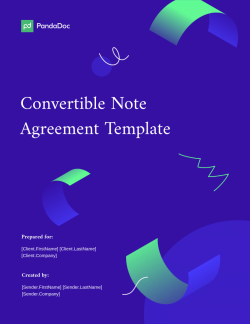When raising money for early-stage startups, finding the right funding solution is tricky.
While investors and venture capital firms of all types are practically throwing money around these days, nailing down the right company valuation and raising a funding round can be a painful and tedious process.
Fortunately, there’s a short-term way to sidestep elongated financing rounds and quickly get your hands on the injection of cash your business desperately needs.
It’s called a convertible note.
In this article, we’ll take a closer look at convertible debt, and how a convertible note template can come in handy when you’re trying to raise funds for your business.
What is a convertible note?
A convertible note is a form of early-stage financing that can mature into equity for an investor farther down the road.
It works like this:
- An early-stage company needs cash but isn’t at a stage where they can determine an appropriate company valuation.
- Without the appropriate valuation, the founder won’t be able to raise capital. Assuming that they have a good valuation, raising that capital through a funding round can take a while.
- If an investor wants to help, the owner can issue a convertible note instead, which allows for a direct infusion of funds without the need for a proper valuation.
- When the convertible note matures — usually during the next equity round — the convertible note holder will gain equity at a discount rate compared to other investors.
Convertible notes are often referred to as an IOU that can be paid off (with accrued interest!) using future equity.
This makes it a powerful fundraising tool since the business doesn’t have to worry about paying back the money over a set period of time.
A typical convertible note will have a date of maturation, often 12 months from the time of issuance, but generally just after the anticipated conclusion of Series A funding.

Convertible Note Agreement Template
Used 6457 times
Startups can negotiate and raise seed funding and angel funding easily with this legal Convertible Note template.
Use this templateWhy use a convertible note?
At the end of the day, it’s worth noting that a convertible note is a loan — not an investment — until it matures into convertible equity.
This distinction allows startup companies and investors to sidestep a lot of paperwork inherent in traditional equity financing while allowing the business to continue its growth trajectory.
However, there may still be hurdles to overcome in the process.
Some investors place special demands on convertible notes to address the inherent problems with valuation in young startups, such as placing a conversion valuation cap on the transaction.
If you and the investor agree to a post-Series A valuation of $3 million, but you actually secure $6 million during your Series A financing round, the investor has the option to buy shares at half price.
This conversion discount can cause dilution by allowing early investors to leverage their lower rates and effectively seize control of your company. This is something you’ll need to account for during your initial rounds of funding.
Another thing to consider before approaching an investor about a convertible note is that, should you fail to reach Series A, you’ll still be required to pay the money back.
Remember: A convertible note is a debt instrument, not a direct investment.
All that aside, convertible notes have certainly helped many startups get going.
If your business outlook is particularly bright, convertible note financing can be a great option for you despite the risks inherent with such short-term debt.
If you’re looking for a success story, take a look at Tesla Motors.
During earlier funding rounds, the company used proceeds from the upsized sale of its convertible debt to prepay Department of Energy loans the company had used to fund the research and development of its Model S sedan.
How do you send a convertible note?
Once you’ve decided that accepting a short-term loan is the right move for your startup, you’ll need to tender it to your would-be investor, negotiate the convertible note terms, and sign the agreement.
This can be an intensive and nerve-wracking process as you and the investor hash out the details — including the conversion value cap, interest rate, and maturity date — and hammer out the deal.
Since the convertible note is not an investment, you can save on legal fees and dispense with some legalese by tendering a loan agreement and working through it with your prospective investor directly.
A tool like PandaDoc allows you to send, track, revise, and ultimately sign your convertible note in the digital realm. The whole process can be done paper-free, in the cloud, and still result in a legally binding agreement.
While forging an agreement for convertible debt seed funding isn’t rocket science, you’ll need to bring your legal and finance departments into the loop to review any unforeseen problems and catch any potential errors.
Though the issuance of preferred stock can cost tens of thousands of dollars, the cost involved in executing a convertible promissory note can be as little as $1,000 to $2,000 in many circumstances, leaving you with even more capital to grow your business.
How do convertible notes work?
When creating a convertible note, the basic idea is to outline the terms and conditions of the deal for all parties involved, then collect signatures from each person.
Typically, this can be done using a non-binding term sheet that will eventually be used to structure the legally binding convertible note at the end of the negotiation.
Sounds simple enough, right?
Not quite. Most investors will want to protect themselves by lowering their risk and getting the most out of the deal.
If your agreement has a conversion value cap or if the risk of defaulting on the debt is significant, the contract will need to address all of those points and deliver terms that the investor finds worthwhile for the risk involved.
Negotiating repayment terms, conversion price, and liquidation preferences may be necessary in order to get the investor on board.
Because of this, the convertible note document itself can get complicated.
Your agreement will need to address many of the investor’s pain points while offering terms that make sense for your business.
To get started, you can use our convertible note template or create your own variation based on it to suit your specific needs. By modifying our template, you can generate the documentation needed to acquire the convertible note quickly and with minimal confusion.
The commenting and feedback features in our document editor also allow investors and their teams to negotiate terms without passing documents back and forth.
If the investment you’re seeking is particularly minor, you may also be able to use a much simpler document, like a convertible promissory note, to streamline the investment process.
If you wind up pitching to a room full of investors, you can personalize the convertible note template for each session and follow up with it after the pitch.
Because each investor is different and may have different terms, using a template is the best option when you’re looking to secure a number of loans in rapid succession.
All you’ll need to do is change the terms of each agreement. The basic language will mostly stay the same from one loan to the next.
Is a convertible note right for your business?
The convertible note has been widely praised in the past few years for empowering founders with new options to raise capital, round up new investors, or finish out seed rounds.
Done correctly, convertible notes can be an ace up your sleeve to secure capital between a round of financing or in the very early pre-money valuation stages when there may be limited interest in what you’re doing.
At the same time, there’s no reason you can’t also accept traditional seed financing from other investors.
Just keep in mind that when convertible notes are disclosed, the discounted share price offered to convertible note investors upon maturity of the debt might offend the traditional seed investors of your business.
All told, convertible debt is one just option of many in the ever-improving world of startup finance.
After all, if it worked for Elon Musk, who wouldn’t want to give it a shot?
Originally published October 26, 2014, updated December 10, 2021
Disclaimer
Parties other than PandaDoc may provide products, services, recommendations, or views on PandaDoc’s site (“Third Party Materials”). PandaDoc is not responsible for examining or evaluating such Third Party Materials, and does not provide any warranties relating to the Third Party Materials. Links to such Third Party Materials are for your convenience and does not constitute an endorsement of such Third Party Materials.

